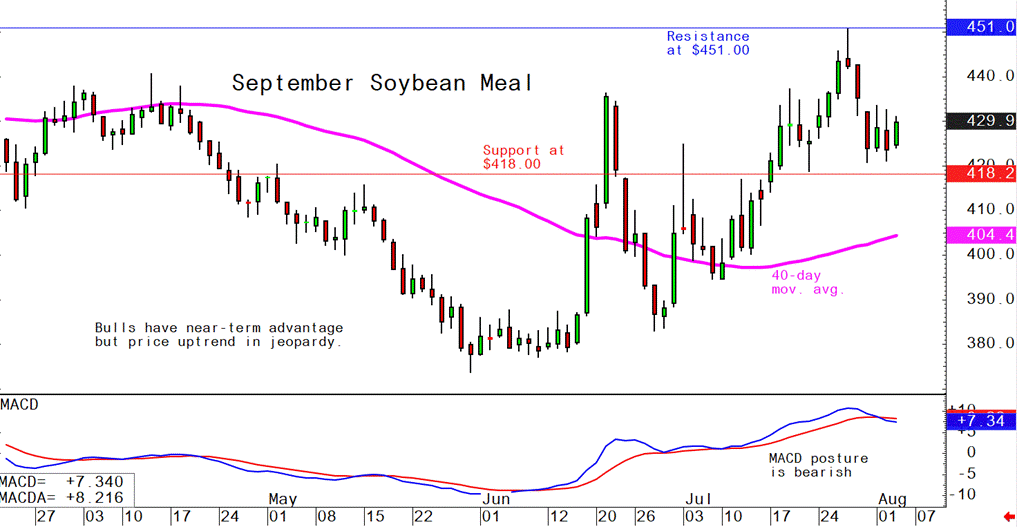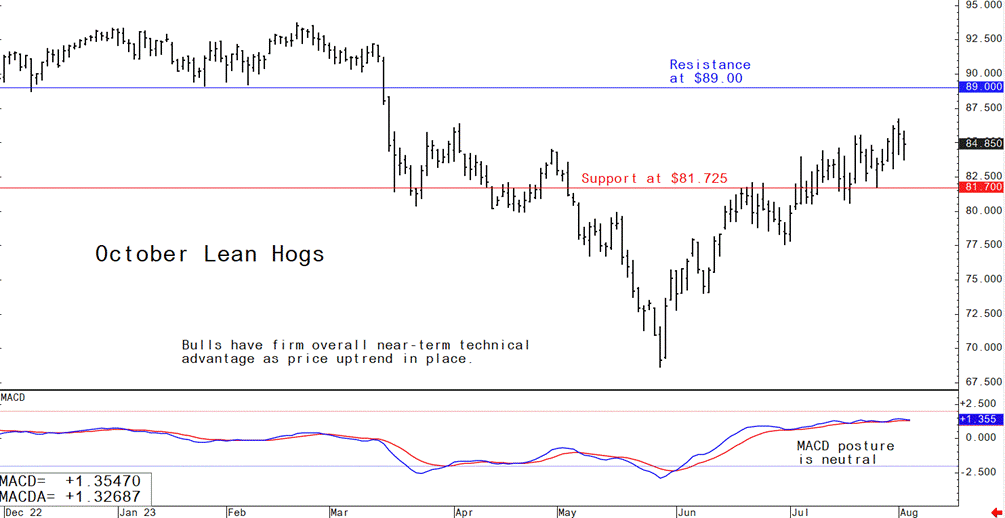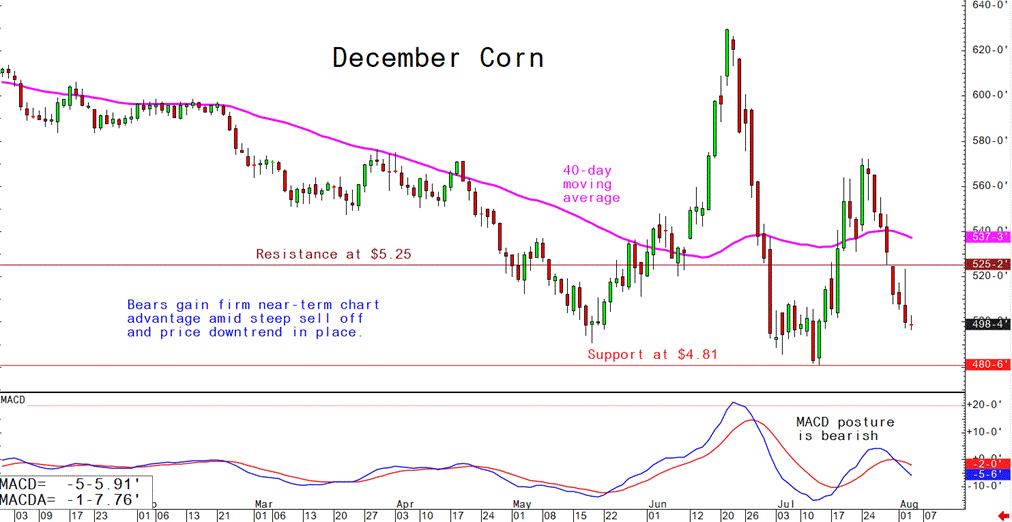



Pig outlook: Lean hog futures bulls keeping uptrend alive
Livestock analyst Jim Wyckoff shared a global pig industry updateThe lean hog futures bulls remain in a solid price uptrend on the daily bar chart and this week hit a 4.5-month high. The latest CME lean hog index is down 10 cents at $105.80. Despite the cash market downturn that bears have been expecting, lean hog futures have remained near the recent highs. That suggests the seasonal price strength may not be coming to an end. Bellies are known to show relative strength this time of year, amid peak BLT season. Look for steady-higher price action in lean hog futures in the near term.
EPA set to address tighter water regulations related to Consolidated Animal Feeding Operations (CAFOs)
This follows a petition filed in 2017. The petition argues that CAFOs manage to bypass necessary permits due to a loophole in the stormwater regulations. The EPA has pledged to respond by Aug. 15, following an agreement reached in the United States Court of Appeals for the Ninth Circuit in April. The groups that initiated the petition have also agreed to voluntarily drop their legal action by Aug. 29, pending the EPA's response.
Weekly USDA export sales for US pork
Pork: US net sales of 17,800 MT for 2023 were down 30 percent from the previous week and 25 percent from the prior 4-week average. Increases primarily for Mexico (7,300 MT, including decreases of 300 MT), Japan (2,800 MT, including decreases of 200 MT), Canada (2,300 MT, including decreases of 400 MT), Colombia (1,900 MT, including decreases of 100 MT), and South Korea (1,200 MT, including decreases of 400 MT), were offset by reductions for the Dominican Republic (100 MT). Exports of 27,100 MT were up 14 percent from the previous week and 4 percent from the prior 4-week average. The destinations were primarily to Mexico (12,300 MT), China (4,500 MT), Japan (3,000 MT), Canada (1,600 MT), and South Korea (1,600 MT).
NPPC’s concerns with Prop 12 compliance
The National Pork Producers Council (NPPC) expressed concerns over the potential difficulties and uncertainty the U.S. pork industry will face due to California’s Proposition 12. The report noted that the law could significantly increase costs for tradespeople and farmers. Complying with the new legislation's requirements would involve constructing pig barns at an estimated expense of $3,400 to $4,000 per sow, a cost increase of approximately 25% compared to traditional communal housing and 40% more than solo stall housing accommodating the same number of animals. NPPC is advocating for a federal resolution to the issues posed by this law.
China maintains position as the world's largest meat importer since 2019
This comes despite a recent decrease in imported meat volumes, according to a USDA Economic Research Service report. In 2022, its imports were 43% higher than those of Japan, the second-largest meat-importing country. Factors such as disease, strict environmental laws, and the departure of small-scale farmers have limited China's meat supply, resulting in an increase in domestic prices and making imports more appealing.
Pork, the most consumed meat in China, generally dictates the nation's meat supply and demand trends. The African swine fever epidemic in 2019 substantially lowered China's pork supply, which boosted its position as the world's top meat importer over Japan. Even though pork production recovered and meat imports subsequently fell, China retained its ranking in 2022.
At the same time, beef imports have been increasing because longer production cycles, insufficient grazing lands, and persistent disease have hindered China's ability to meet domestic beef demand. Chinese consumers are also consuming more poultry—mainly because it tends to be the most affordable meat—yet rising feed costs and diseases have inflated domestic poultry prices, leading to higher poultry imports.
While China's meat consumption appeared to reach a peak after 2014, statistical models project that consumption will continue to rise through 2031. Trends such as changes in diet and moderate growth in income and prices drive this prediction. However, the Covid-19 pandemic and subsequent economic downturn in 2022 have dampened consumption and the associated import prospects. Other factors — like ongoing disease risks and the high cost of livestock feed, which lowers profitability for local producers — continue to impact the market.
New Jersey Governor Phil Murphy signed legislation banning sow crates and veal-calf stalls
Activists say the stalls significantly limit the mobility of the animals. By implementing this law, New Jersey becomes the 15th U.S. state to inhibit the use of such restraints, including "battery" cages for egg-laying hens, as announced by the Humane Society of the United States, a strong advocate for this legislation.
The new regulation seeks to ban gestation crates that severely confine the movements of breeding pigs before birth, as they represent an intolerable degree of cruelty, according to state Senate President Nick Scutari, one of the bill's sponsors. The law mandates that the state Agriculture Department establishes, within six months, rules and protocols governing the confinement and treatment of breeding sows and veal calves. Some exceptions exist, such as the two weeks before sows are about to give birth or when they are nursing piglets.
Triumph Foods, a pork processor company, has filed a lawsuit questioning the legality of a voter-initiated law in Massachusetts. This law requires farmers to allot more space to breeding sows, and restricts the sale of pork produced on farms situated outside the state that fail to meet the Massachusetts standard. A similar law, California’s Proposition 12, was recently deemed constitutional by the U.S. Supreme Court; however, Triumph Foods' argument is that the ruling was based on specific claims, not on the principle itself, suggesting that future challenges are possible. Additionally, Triumph Foods is seeking a delay in implementing the Massachusetts law, known as Question 3, until their case is resolved. The law was set to come into effect on Aug. 24. Triumph Foods headquarters is located in St Joseph, Missouri.
Of note: The so-called EATS Act, the livestock industry's answer to California's Proposition 12, could jeopardize more than 1,000 health, safety, and welfare laws on the state level and threaten states' rights, said a report by a Harvard Law School group. Link for details.
Economic update analyzes pork industry issues and dynamics
The National Pork Producers Council (NPPC) released its third quarter pork industry economic update to provide a snapshot of top pork industry issues, current trends, and marketing conditions impacting U.S. pig farmers.
Key takeaways from the Q3 update include:
- California Proposition 12 creates significant challenges and market uncertainty for pig farmers across the country and has far-reaching implications beyond the pork industry.
- Persistently high production costs continue to be a major challenge to pig farmers’ profitability. Average cost and breakeven levels are 9% higher than one year ago and have increased 60% over three years.
- So far this year, negotiated hog and pork cutout values, on average, have been about 20% below the same week last year. Prices have gained seasonal momentum over the past three months but remain below year-ago levels.
- Hog slaughter and pork production increased an estimated 1.2% and 0.3% respectively through mid-July 2023. USDA is now projecting a 1.4% increase in pork production this year, while domestic pork availability is expected to drop 2.5% to 49.8 pounds per capita for 2023.
- Inflation has cooled to 3.1%, though the prices of many consumer necessities like food and housing continue to increase more rapidly than the pre-pandemic average. Inflation, rising interest rates, and other macro-level factors may continue to strain consumer purchasing power, which impacts demand for meat and pork.
“The U.S. pork industry is incredibly important not only to agriculture but to the entire U.S. economy,” said Scott Hays, NPPC president and pork producer from Missouri. “As producers face an unprecedented economic environment caused by dynamic market conditions and exacerbated further by California Proposition 12, our industry is incredibly resilient as demonstrated by generations of farm families who continue to take pride in producing affordable, nutritious protein for consumers.”
The next week’s likely high-low price trading ranges:
October lean hog futures--$83.00 to $88.00 and with a sideways-higher bias
September soybean meal futures--$420.00 to $450.00, and with a sideways bias
December corn futures--$4.81 to $5.25 and a sideways bias
Latest analytical daily charts lean hog, soybean meal and corn futures










